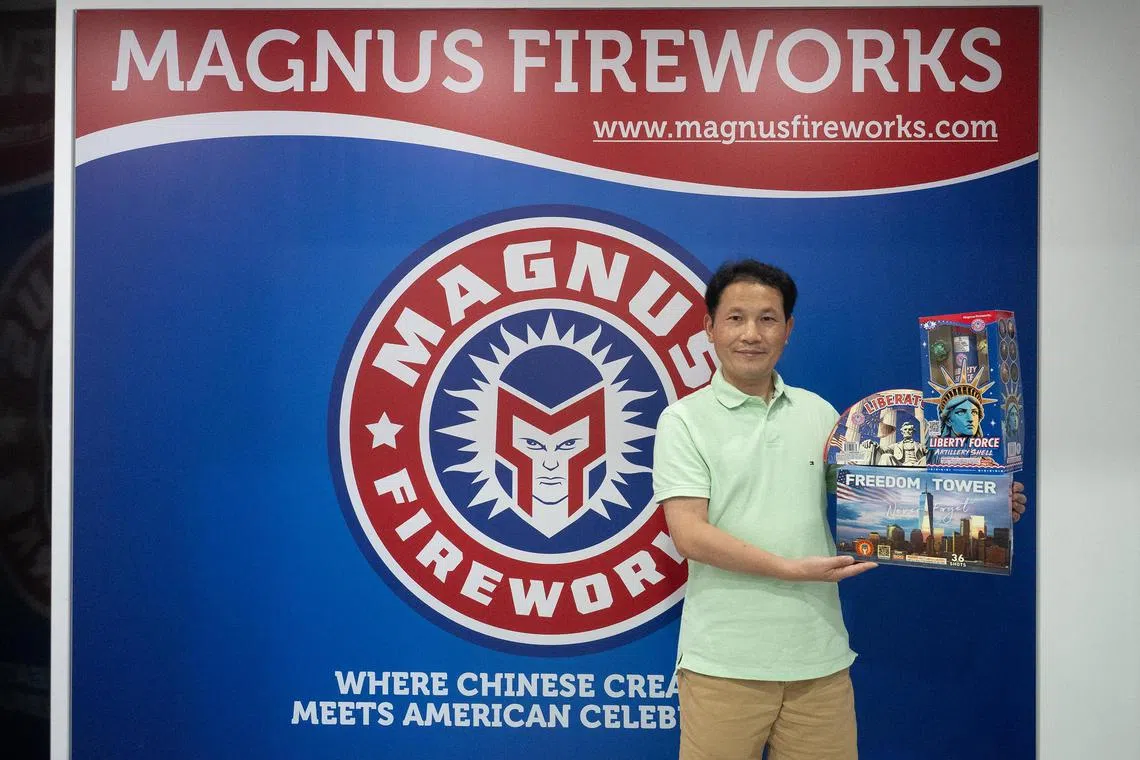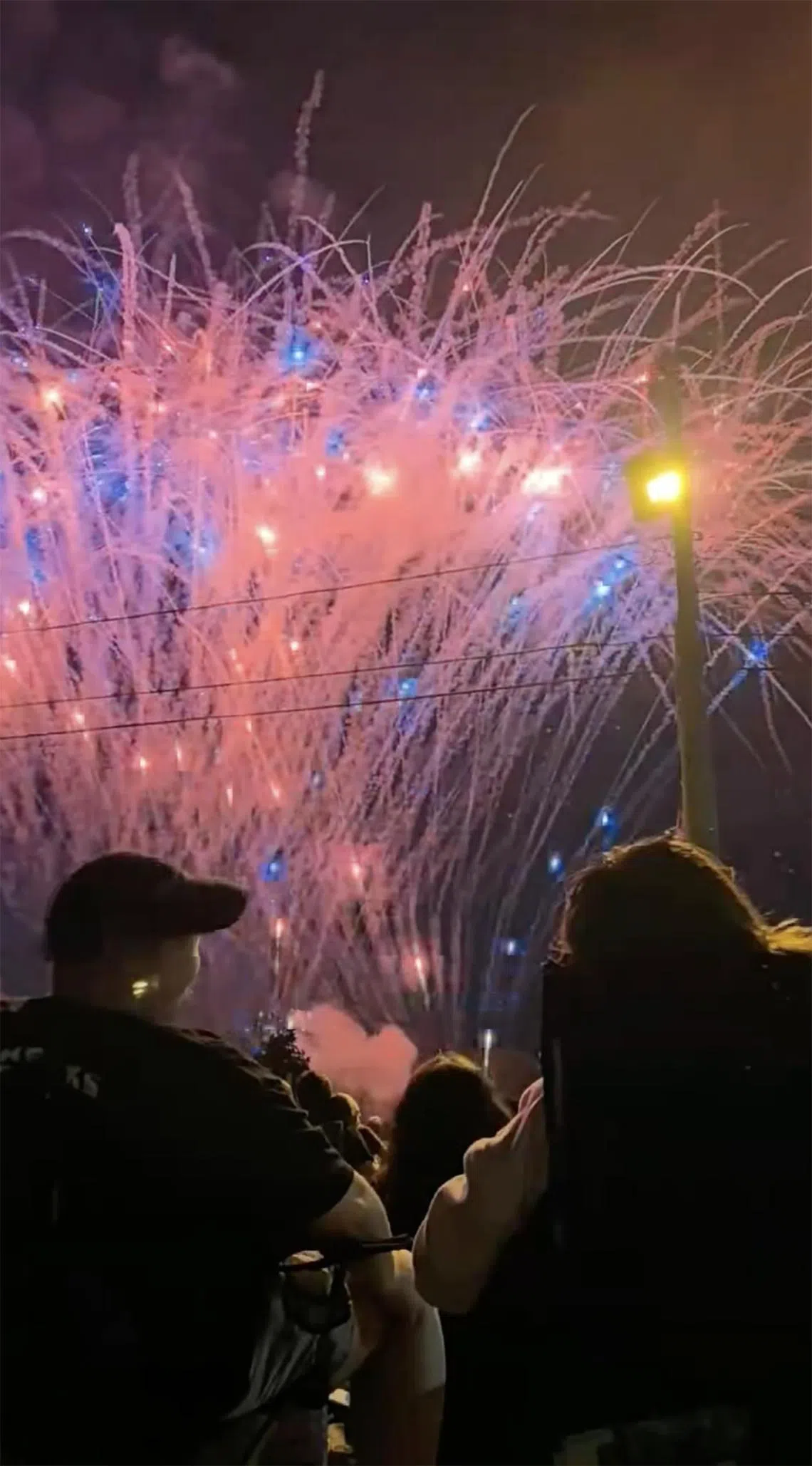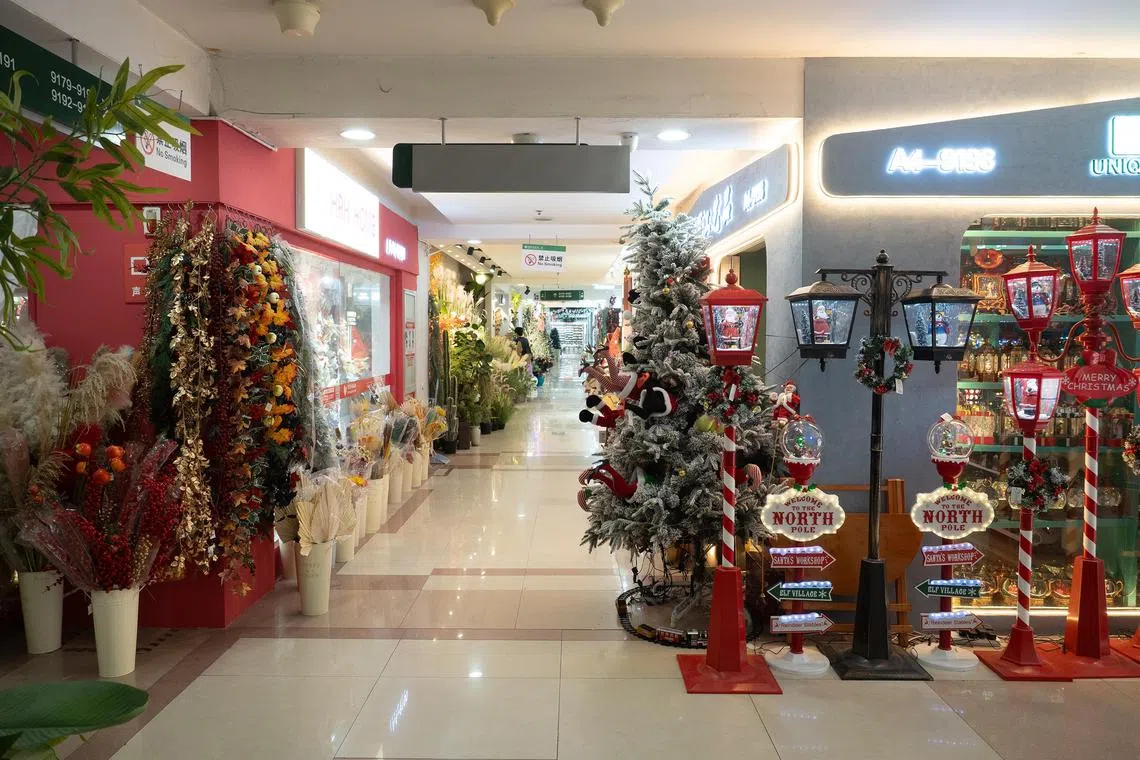‘America needs fireworks’: No alternative for some Chinese goods amid trade uncertainty
Sign up now: Get ST's newsletters delivered to your inbox

Mr Marx Wu with some of his company’s fireworks products for the US Fourth of July celebrations, at his office in Liuyang, Hunan province.
ST PHOTO: LIM MIN ZHANG
Follow topic:
- US tariffs on Chinese goods, including fireworks, impact businesses; a 30% tariff increase complicates trade for US importers.
- Liuyang, China's fireworks hub in Hunan, faces challenges, but its industry strengths and US reliance create optimism; 90% of US fireworks come from China.
- Despite trade tensions, US-China economic ties persist; China remains a key trade partner with diversification efforts present among manufacturers.
AI generated
LIUYANG/YIWU - Fourth of July celebrations in the US may have just passed, but Chinese businessman Marx Wu is already prepared for the dampening effect of tariffs on sales of his fireworks to American customers for the festivities in 2026.
This is due to the additional 30 per cent tariffs that US President Donald Trump has been imposing on China – since the outbreak of a trade war between the two countries in April – in a bid to bring back manufacturing to the US.
“Customers will be more cautious because their costs have increased significantly,” Mr Wu told The Straits Times.
His company, Magnus Fireworks, is based in Hunan province’s Liuyang city, which is dubbed China’s “fireworks’ home town” for its expertise in manufacturing pyrotechnics. The US government now collects a 35.7 per cent tax from American importers of fireworks from China.
The bulk of these sales is meant for the annual US Independence Day celebrations, synonymous with fireworks displays.
Such orders are typically made a year in advance.
But Mr Wu, who sells mainly to the US, remains optimistic about his business’ viability in the longer term, because the strengths of the Chinese industry in Liuyang cannot be easily replicated elsewhere, he said.
Unpacking the impact of Mr Trump’s aggressive tariff strategy on Chinese manufacturers

Magnus Fireworks’ products being tested in Liuyang city, Hunan province, China.
PHOTO: MAGNUS FIREWORKS
On the one hand, Mr Trump’s move to impose tariffs across the board on Chinese goods in April has led to factory closures and worker layoffs in certain sectors such as the garment industry, and accelerated efforts by some exporters to diversify away from the US market.
On the other hand, there are products that have few to no alternatives to “made in China”, as the country’s manufacturers are overwhelmingly competitive, experts say.
When Mr Trump proclaimed “Liberation Day” on April 2 with “reciprocal tariffs” on the US’ trading partners, Beijing and Washington engaged in a tit-for-tat tariff war. At one point, American importers had to pay a 145 per cent tax on Chinese goods.
But bilateral trade talks since May 12 have de-escalated the situation. US and Chinese officials are set to meet in Stockholm next week, from July 27, to discuss a possible extension of a 90-day truce.
The fireworks industry presents a case study showing how, despite trade tensions and strategic competition, the US and China remain economically intertwined.
While American businesses now adopt a cautious approach in placing orders, deals have continued to flow as Chinese manufacturers remain competitive.
Liuyang has, over decades, accumulated the technical know-how, quality raw materials, proper regulatory oversight and strict transportation requirements, Mr Wu said.
Factories dot the surrounding mountainous terrain of the city, which is about an hour’s drive from the inland Hunan capital of Changsha. Production pauses for about a month each summer due to safety concerns from the heat.
“America needs fireworks – this will not change,” Mr Wu said.
“At the very most, they will buy fewer, but they will not stop buying completely. In addition, we have good relations with our customers who trust in our products, and they also believe that this (tariff issue) is temporary.”

Screenshot from a video Mr Wu took of a Fourth of July fireworks celebration in Ohio earlier in July. His company’s products were used.
PHOTO: MARX WU
According to the American Pyrotechnics Association, 90 per cent of professional display fireworks used in the US are imported from China.
Reports say that US companies import close to US$400 million (S$512 million) worth of consumer fireworks from China each year.
More than 200 other imported products rely on China for over 90 per cent of their supply, including baby carriages, vacuum flasks, umbrellas and artificial plants.
Mr Stephen Olson, a visiting senior fellow at the ISEAS – Yusof Ishak Institute in Singapore who specialises in international trade, said that despite the conflict and tension, trade between the US and China has remained remarkably resilient.
Although China’s exports to the US declined in the first half of the year, the country remains among the US’ largest trade partners and will continue to be so for the foreseeable future, he said.
China’s exports to the US declined by 10.7 per cent in the first half of 2025 compared with the same period in 2024, a drop of US$25.7 billion.
“Trump’s tariffs have undoubtedly dented China’s cost competitiveness, but the resilience of China’s exports reflects the simple fact that China is the world’s pre-eminent manufacturer and is overwhelmingly competitive in a host of consumer products and industrial inputs.
“It’s simply not possible to cut China entirely out of US consumer markets or supply chains,” Mr Olson said.
Mr Steve Houser, president of Missouri-based Red Rhino Fireworks, who was on a work trip to China, said he has already placed his orders for 2026 but added that he – like other major importers – was doing so much more cautiously.
“I’m being very particular on what I order. I’m ordering only what I really, really need. I’m not really taking chances on other things because of the tariff rates; the goods are costing me a lot more,” he told ST.
He said the National Fireworks Association in the US was recently in Washington, DC, to make the case that fireworks should be exempt from the across-the-board tariffs of 30 per cent, as there are no viable alternative suppliers from other countries.
Beyond the fireworks business, the US-China trade war has resulted in uncertainty for many exporters, including those in Yiwu, Zhejiang province – home to the world’s largest wholesale market for small commodities.
The sprawling Yiwu International Trade City hosts more than 70,000 shops selling products ranging from cosmetics and stationery, to backpacks and Christmas decorations.
Most shops that stocked Halloween and Christmas decorations at the trade city declined to speak with ST in early July, which is typically the peak sales season for such products.
A few shop owners said only that business was slower in 2025, while others said they were not authorised to speak to the media.

Rows of shops selling Christmas decorations at Yiwu International Trade City in Zhejiang province were largely empty when ST visited in early July.
ST PHOTO: LIM MIN ZHANG
Ms Guo Xiabing, an entrepreneur in Zhejiang who runs a factory making Christmas trees in Yiwu, said that US customers are typically more able to afford higher-priced products, such as those with more fanciful ornaments.
She shared her factory’s race to ship orders during the 90-day trade truce between the US and China in a documentary aired in June.
“Customers also do not want to give up on the orders. But that also means that we are left hanging, not knowing when we can resume production and shipping.
“This type of uncertainty causes a lot of anxiety. Should we let go of the workers? How would we find jobs for them?” she said.
Others, however, have taken a longer-term view and made efforts to diversify away from the US market.
Mr Wu Xiaoming, chief executive of Aokai Sporting Goods in Yiwu who has been in the industry for 30 years, counts the South American and African markets as his major customers – at about 50 per cent and 20 per cent respectively – with the US market accounting for only about 5 per cent.

Mr Wu Xiaoming, chief executive of Aokai Sporting Goods in Yiwu, inspecting a football bound for Nicaragua at his factory in Yiwu city, Zhejiang province.
ST PHOTO: LIM MIN ZHANG
He recalled receiving a call from an American customer to resume an order on May 13 – shortly after news of successful US-China trade talks in Geneva were announced – and to place a new order for 90,000 footballs. His US orders are mainly for supermarkets.
“For the US market, the volume is still there. But it is US consumers who have to bear the cost (of the tariffs). If you force us to lower our costs, it means the quality of the product suffers – so ultimately it’s still the consumers who pay the bill,” Mr Wu said.
He believes that diversification is necessary for his company’s viability, not only because of trade frictions, but also due to other sources of instability. He cited examples such as a Croatian client who halted a shipment due to the Kosovo War in 1998, and how demand from Russia has plummeted because of the Ukraine war.
“There has not been a period where the entire world was completely at peace... In Yiwu, we engage in global trade, and we should work to ensure that if the West doesn’t shine, the East will.”


